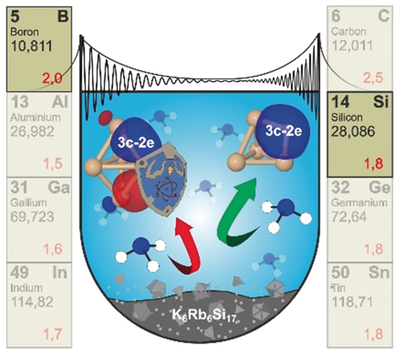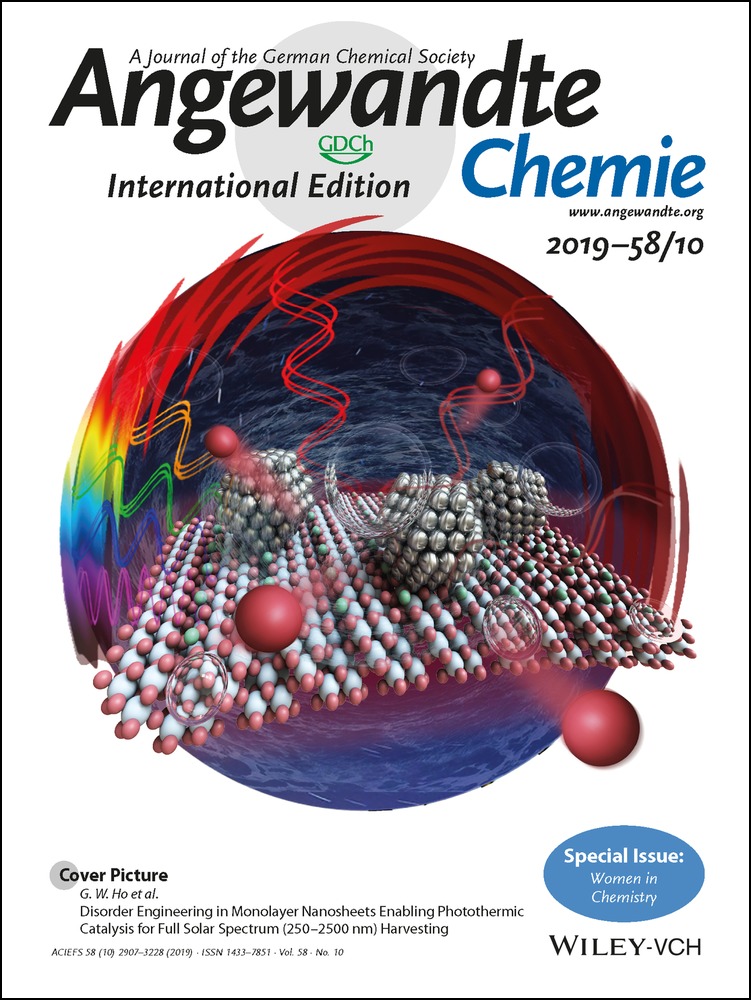Elusive Zintl Ions [μ-HSi4]3− and [Si5]2− in Liquid Ammonia: Protonation States, Sites, and Bonding Situation Evaluated by NMR and Theory
Florian Hastreiter
Organic Chemistry, University of Regensburg, 93040 Regensburg, Germany
These authors contributed equally to this work.
Search for more papers by this authorCorinna Lorenz
Inorganic Chemistry, University of Regensburg, 93040 Regensburg, Germany
These authors contributed equally to this work.
Search for more papers by this authorDr. Johnny Hioe
Organic Chemistry, University of Regensburg, 93040 Regensburg, Germany
These authors contributed equally to this work.
Search for more papers by this authorDr. Stefanie Gärtner
Inorganic Chemistry, University of Regensburg, 93040 Regensburg, Germany
Search for more papers by this authorDr. Nanjundappa Lokesh
Organic Chemistry, University of Regensburg, 93040 Regensburg, Germany
Search for more papers by this authorCorresponding Author
Prof. Dr. Nikolaus Korber
Inorganic Chemistry, University of Regensburg, 93040 Regensburg, Germany
Search for more papers by this authorCorresponding Author
Prof. Dr. Ruth M. Gschwind
Organic Chemistry, University of Regensburg, 93040 Regensburg, Germany
Search for more papers by this authorFlorian Hastreiter
Organic Chemistry, University of Regensburg, 93040 Regensburg, Germany
These authors contributed equally to this work.
Search for more papers by this authorCorinna Lorenz
Inorganic Chemistry, University of Regensburg, 93040 Regensburg, Germany
These authors contributed equally to this work.
Search for more papers by this authorDr. Johnny Hioe
Organic Chemistry, University of Regensburg, 93040 Regensburg, Germany
These authors contributed equally to this work.
Search for more papers by this authorDr. Stefanie Gärtner
Inorganic Chemistry, University of Regensburg, 93040 Regensburg, Germany
Search for more papers by this authorDr. Nanjundappa Lokesh
Organic Chemistry, University of Regensburg, 93040 Regensburg, Germany
Search for more papers by this authorCorresponding Author
Prof. Dr. Nikolaus Korber
Inorganic Chemistry, University of Regensburg, 93040 Regensburg, Germany
Search for more papers by this authorCorresponding Author
Prof. Dr. Ruth M. Gschwind
Organic Chemistry, University of Regensburg, 93040 Regensburg, Germany
Search for more papers by this authorGraphical Abstract
Long ago Zintlsized and now analyzed: 29Si and 1H NMR experiments confirm the existence of Zintl ions [μ-HSi4]3− and [Si5]2− in liquid ammonia. For [μ-HSi4]3−, NMR and theoretical calculations reveal a bridging hydrogen atom forming a 3c-2e-bond. Additionally, [Si5]2−, only known from solvate crystal structures so far, was characterized by 29Si NMR. Here, NBO analysis indicates the formation of three localized 3c-2e-bonds.
Abstract
The existence of [μ-HSi4]3− in liquid ammonia solutions is confirmed by 1H and 29Si NMR experiments. Both NMR and quantum chemical calculations reveal that the H atom bridges two Si atoms of the [Si4]4− cluster, contrary to the expectation that it is located at one vertex Si of the tetrahedron. The calculations also indicate that in the formation of [μ-HSi4]3−, protonation is driven by a high charge density and an increase of electron delocalization compared to [Si4]4−. Additionally, [Si5]2− was detected for the first time and characterized by NMR. Calculations show that it is resistant to protonation, owing to a strong charge delocalization, which is significantly reduced upon protonation. Thus, our methods reveal three silicides in liquid ammonia: unprotonated [Si5]2−, terminally protonated [HSi9]3−, and bridge-protonated [μ-HSi4]3−. The protonation trend can be roughly predicted by the difference in charge delocalization between the parent compound and the product, which can be finely tuned by the presence of counter ions in solution.
Supporting Information
As a service to our authors and readers, this journal provides supporting information supplied by the authors. Such materials are peer reviewed and may be re-organized for online delivery, but are not copy-edited or typeset. Technical support issues arising from supporting information (other than missing files) should be addressed to the authors.
| Filename | Description |
|---|---|
| anie201812955-sup-0001-misc_information.pdf1.6 MB | Supplementary |
Please note: The publisher is not responsible for the content or functionality of any supporting information supplied by the authors. Any queries (other than missing content) should be directed to the corresponding author for the article.
References
- 1W. Preetz, G. Peters, Eur. J. Inorg. Chem. 1999, 1831–1846.
10.1002/(SICI)1099-0682(199911)1999:11<1831::AID-EJIC1831>3.0.CO;2-J CAS Web of Science® Google Scholar
- 2E. L. Muetterties, F. Klanberg, Inorg. Chem. 1966, 5, 315–316; F. Klanberg, E. L. Muetterties, Inorg. Chem. 1966, 5, 1955–1960.
- 3A. R. Pitochelli, F. M. Hawthorne, J. Am. Chem. Soc. 1960, 82, 4427–4428; H. C. Longuet-Higgins, M. d. V. Roberts, Proc. R. Soc. London Ser. A 1955, 230, 110–119.
- 4H. G. von Schnering, W. Hoenle, Chem. Rev. 1988, 88, 243–273.
- 5M. Scheer, G. Balazs, A. Seitz, Chem. Rev. 2010, 110, 4236–4256.
- 6A. F. Holleman, E. Wiberg, N. Wiberg, Anorganische Chemie, 103rd ed., de Gruyter, Berlin, 2017.
- 7A. Schnepf, Chem. Soc. Rev. 2007, 36, 745–758; P. Willmes, K. Leszczynska, Y. Heider, K. Abersfelder, M. Zimmer, V. Huch, D. Scheschkewitz, Angew. Chem. Int. Ed. 2016, 55, 2907–2910; Angew. Chem. 2016, 128, 2959–2963; Y. Heider, D. Scheschkewitz, Dalton Trans. 2018, 47, 7104–7112.
- 8S. Gärtner, N. Korber in Structure and Bonding, Vol. 140 (Ed.: ), Springer, Berlin, 2011.
- 9S. Scharfe, F. Kraus, S. Stegmaier, A. Schier, T. F. Fässler, Angew. Chem. Int. Ed. 2011, 50, 3630–3670; Angew. Chem. 2011, 123, 3712–3754.
- 10K. Wiesler, K. Brandl, A. Fleischmann, N. Korber, Z. Anorg. Allg. Chem. 2009, 635, 508–512.
- 11C. Lorenz, S. Gärtner, N. Korber, Crystals 2018, 8, 276.
- 12J. D. Corbett, P. A. Edwards, Chem. Commun. 1975, 984–985; M. Somer, W. Carrillo-Cabrera, E. M. Peters, K. Peters, M. Kaupp, H. G. von Schnering, Z. Anorg. Allg. Chem. 1999, 625, 37–42.
- 13M. Neumeier, F. Fendt, S. Gärtner, C. Koch, T. Gärtner, N. Korber, R. M. Gschwind, Angew. Chem. Int. Ed. 2013, 52, 4483–4486; Angew. Chem. 2013, 125, 4579–4582.
- 14F. Fendt, C. Koch, M. Neumeier, S. Gärtner, R. M. Gschwind, N. Korber, Chem. Eur. J. 2015, 21, 14539–14544.
- 15F. S. Kocak, B. Eichhorn, Structure and Bonding, Vol. 140, Springer, Berlin, 2011.
- 16M. Baudler, K. Glinka, Chem. Rev. 1993, 93, 1623–1667.
- 17V. Quéneau, E. Todorov, S. C. Sevov, J. Am. Chem. Soc. 1998, 120, 3263–3264.
- 18S. Joseph, C. Suchentrunk, F. Kraus, N. Korber, Eur. J. Inorg. Chem. 2009, 4641–4647.
- 19S. Joseph, C. Suchentrunk, N. Korber, Z. Naturforsch. B 2010, 65, 1059–1065; J. M. Goicoechea, S. C. Sevov, J. Am. Chem. Soc. 2004, 126, 6860–6861.
- 20J. M. Goicoechea, S. C. Sevov, Inorg. Chem. 2005, 44, 2654–2658.
- 21T. Henneberger, W. Klein, T. F. Fässler, Z. Anorg. Allg. Chem. 2018, 644, 1018–1027.
- 22T. F. Fässler, L. Schiegerl, A. Karttunen, J. Tillmann, S. Geier, G. Raudaschel-Sieber, M. Waibel, Angew. Chem. Int. Ed. 2018, 57, 12950–12955; Angew. Chem. 2018, 130, 13132–13137.
- 23C. Lorenz, F. Hastreiter, J. Hioe, N. Lokesh, S. Gärtner, N. Korber, R. M. Gschwind, Angew. Chem. Int. Ed. 2018, 57, 12956–12960; Angew. Chem. 2018, 130, 13138–13142.
- 24C. Lorenz, S. Gärtner, N. Korber, Z. Anorg. Allg. Chem. 2017, 643, 141–145.
- 25C. B. Benda, T. Henneberger, W. Klein, T. F. Fassler, Z. Anorg. Allg. Chem. 2017, 643, 146–148.
- 26W. Lu, C. M. Lieber, Nat. Mater. 2007, 6, 841–850; M. L. Snedaker, Y. C. Zhang, C. S. Birkel, H. Wang, T. Day, Y. F. Shi, X. L. Ji, S. Kraemer, C. E. Mills, A. Moosazadeh, M. Moskovits, G. J. Snyder, G. D. Stucky, Chem. Mater. 2013, 25, 4867–4873; B. K. Teo, X. H. Sun, Chem. Rev. 2007, 107, 1454–1532.
- 27F. S. Kocak, D. O. Downing, P. Zavalij, Y. F. Lam, A. N. Vedernikov, B. Eichhorn, J. Am. Chem. Soc. 2012, 134, 9733–9740.
- 28Fässler and co-workers refer, in a footnote, to the calculation and detection of CCSD(T) shifts (+225 ppm and −455 ppm) of [Si5]2− in Ref. [22].
- 29A. Wiesner, S. Steinhauer, H. Beckers, C. Müller, S. Riedel, Chem. Sci. 2018, 9, 7169–7173.
- 30Gaussian window function and zero filling gives minimal linewidths of circa 3 Hz.
- 31N. Wiberg, G. Wagner, G. Muller, Angew. Chem. Int. Ed. Engl. 1985, 24, 229–230; Angew. Chem. 1985, 97, 220–222; K. M. Baines, A. G. Brook, R. R. Ford, P. D. Lickiss, A. K. Saxena, W. J. Chatterton, J. F. Sawyer, B. A. Behnam, Organometallics 1989, 8, 693–709.
- 32C. N. Smit, F. Bickelhaupt, Organometallics 1987, 6, 1156–1163.
- 33M. Driess, H. Pritzkow, S. Rell, Organometallics 1996, 15, 1845–1855.
- 34K. W. Klinkhammer, W. Schwarz, Angew. Chem. Int. Ed. Engl. 1995, 34, 1334–1336; Angew. Chem. 1995, 107, 1448–1451.
- 35Uniform distribution of uncorrelated electrons over the number of vertex atoms/volume.
- 36Recently, Fässler et al. published a communication on the compound [K([18]crown-6)] [Rb([18]crown-6)]2[HGe4ZnPh2]⋅8 NH3, which contains a protonated tetragermanide cluster, in T. Henneberger, W. Klein, J. Dums, T. F. Fässler, Chem. Commun. 2018, https://doi.org/10.1039/C8CC06843G. Here, the H atom also bridges the edge of the cluster.
- 37The bridging H atom conformer [μ-HSi9]3− was only predicted as a high-energy intermediate (+68.5 kJ mol−1) in the H-hopping mechanism (see Ref. [23]).
- 38F. Weinhold, C. R. Landis, Valency and Bonding: A Natural Bond Orbital Donor-Acceptor Perspective, Cambridge University Press, Cambridge, 2005, p. 760.
10.1017/CBO9780511614569 Google Scholar
- 39A situation similar to the one reported for the heavier homologue [Ge5]2−, where six three-center two-electron bonds (3c-2e) were predicted by AdDNP analysis. In this case, much more localized 3c-2e bonds were obtained. C. Liu, L. J. Li, Q. J. Pan, Z. M. Sun, Chem. Commun. 2017, 53, 6315–6318.
- 40J. D. Corbett, Struct. Bonding (Berlin) 1997, 87, 157.
- 41T. F. Fässler, Coord. Chem. Rev. 2001, 215, 347–377.





